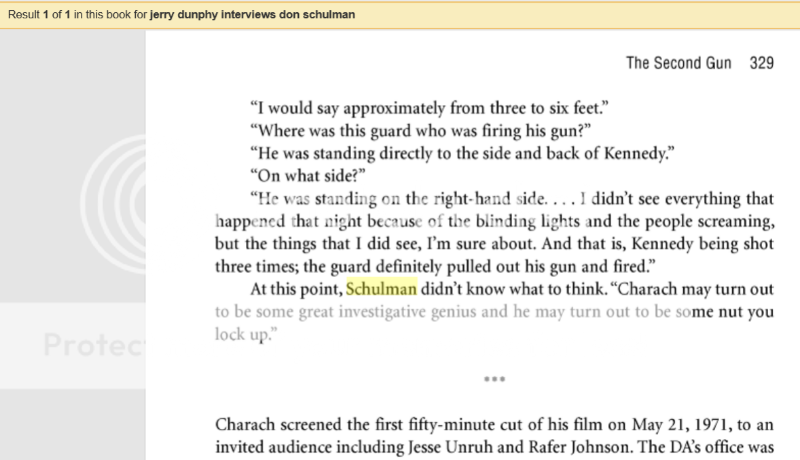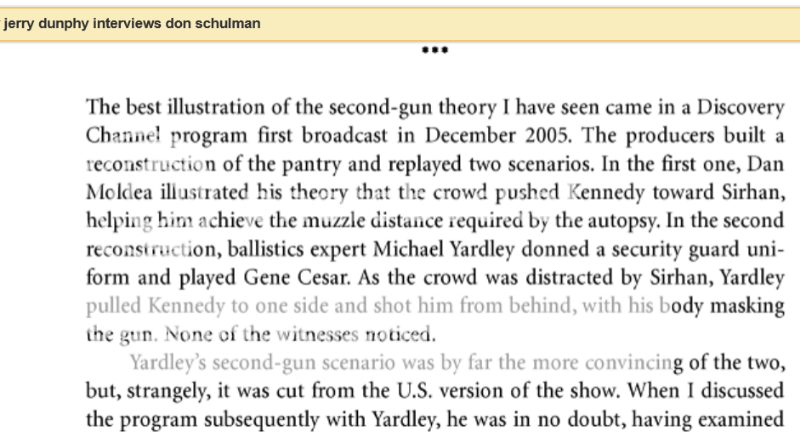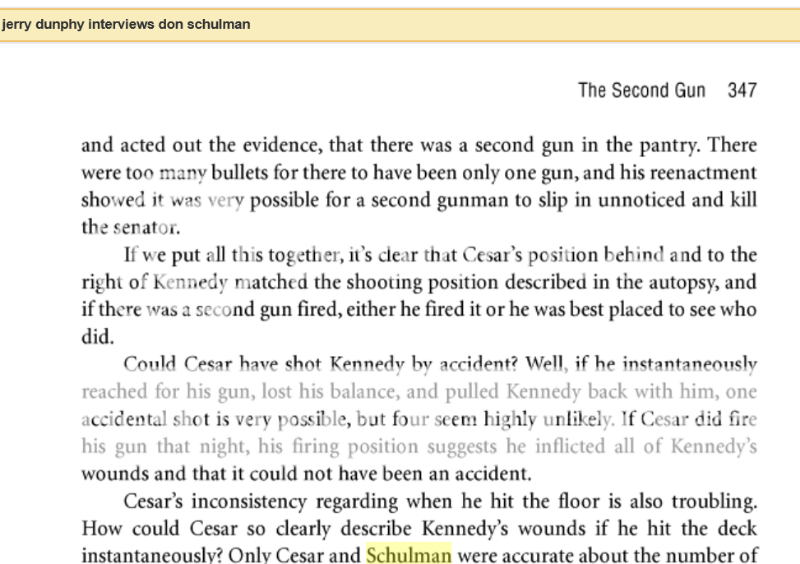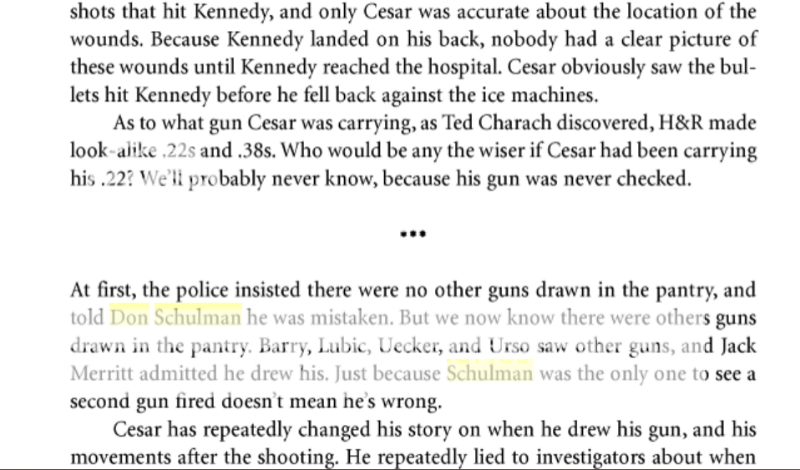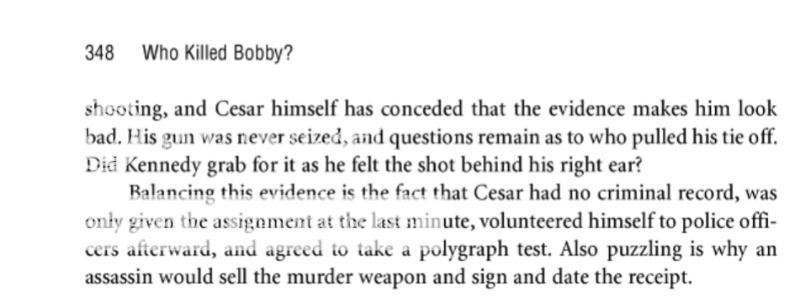vyo476
Well-Known Member
Here's an interesting one: there is significant evidence today that there was a second shooter involved in the assassination of Robert Kennedy.
First, from CrimeLibrary:
http://www.crimelibrary.com/terrorists_spies/assassins/kennedy/6.html
Three eyewitnesses all confirm the presence of a woman (the same woman, as descriptions of her nose and clothing match between all three witnesses) who was, by their description, at least an acquaintance of Sirhan Sirhan, the assassin. A third person, male, is also described by two of the witnesses.
The LAPD discounts this evidence. They never bother to explain why. Three eyewitnesses specifically remember this woman (also specifically accompanied by a male partner), two of whom saw them at times/in places where others wouldn't have had cause to remember them (thereby discounting the idea that the police sluffed her off due to a whole bunch of other people not mentioning her). Indeed, the people inside the building wouldn't have noted either of them; if they were participants in the shooting, they timed their shots to coincide with Sirhan's shots, during which time all attention was already on Sirhan (more on that in a minute). If they didn't actually do any shooting themselves there's even less of a reason for anyone on the inside to have noted them (the inside witness who did mention the woman, a waiter, only recalled her because she was attractive, but had a "funny nose," a statement which would later be corollated to one of the exterior witness' descriptions of the woman as having a pug nose).
One of the exterior witnesses, Sandra Serrano, was adamant about having seen the woman (and her male accompaniment). Here's a partial transcript of her interrogation on the matter (the actual interrogation lasted over an hour):
The LAPD would later officially say this interogation employed "standard tactics." Serrano was subjected to a lie detector test after the interogation, which she failed.
The LAPD also later released a statement saying that the waiter had admitted to embellishing his story; he hadn't seen a woman in a polka dot dress with a pug nose. However, later interviews with a woman named Valerie Schulte, who was herself wearing a polka dot dress that night, revealed that she had been standing in the location the waiter had indicated (though she said she didn't know nor had spoken to Sirhan). So the waiter probably did see a woman in a polka dot dress standing where he'd said she was standing. Why, then, did he recant his statement?
Finally, the last exterior witness, Seargant Paul Sharaga, himself a Los Angeles police officer, had his statement recanted for him by the LAPD. He himself never did so, and would years later stick by his original description of events.
Note that the LAPD is directly responsible for all three discreditations: bullying Serrano into a nervous panic and then getting her to fail a lie detector test, releasing a statement that the waiter had embellished his story and hadn't really seen a woman in a polka dot dress standing where he'd seen her when later evidence would show that he probably did, and speaking for one of their own officers in order to bury the story of the woman in the polka dot dress.
There are, of course, problems with these contentions. The biggest problem lies with the waiter's statement changes. If Valerie Schulte was the woman in the polka dot dress he'd seen, how could he have mentioned the "funny" nose on the woman who ran away (a defining characteristic also mentioned by Serrano)? There are a number of plausible explanations for what occured:
1. The waiter's admission of embellishment was genuine; he only embellished on the detail of the nose. He really did see a woman in polka dot dress - Valerie Schulte.
2. The waiter's admission of embellishment was genuine; he made the whole thing up, and Valerie Schulte's presence in the location described was a coincidence.
3. The waiter's admission of embellishment was forced, but partially truthful; while the woman he saw did turn out to be Valerie Schulte, he was coerced into changing his story to protect another woman (the woman seen by Serrano and Seargent Sharaga). He either did embellish on the story or didn't see her clearly as she does not have the pug nose descrbied by Serrano (or, for that matter, a nose of any note at all).
4. The waiter's admission of embellishment was forced; he saw the same woman that Serrano and Sharaga saw later, and Schulte's presence in the same location that the woman with the pug nose (a trait Schulte lacks) was a coincidence the LAPD hadn't planned for when they coerced the waiter into changing his story.
In any case, Valerie Schulte's testimony is not the smoking gun many conspiracy theorists originally pointed it out to be. After all, if Valerie Schulte is the woman the waiter remembers, than he didn't see the woman observed by Serrano and Sharaga (scenario 1 above). Both of the conspiary theory scenarios above are predicated on unreliable information: either the waiter did lie somewhat about the nose or didn't see the nose clearly (scenario 3) or two women wearing strikingly similar dresses stood in the same place at different times and the waiter only observed one of them.
The other two stories, however, are harder to discredit. The polygraph test in particular was a cheap trick. An hour of getting yelled at over the same issue frayed Serrano's nerves and built up a strong, subconscious emotional reaction to questions relating to that issue. When the polygraph was administered a short time later, her strong physiological reactions to questions pertaining to the woman in the polka dot dress had more to do with her recent, stressful interogation than do with whether or not she was lying. As for Sharaga, what was done speaks for itself. He never recanted his story the way the LAPD stated he did. The deicision to recant his statement came from over his head, and words were put into his mouth by the department.
Part Two will be up shortly.
First, from CrimeLibrary:
http://www.crimelibrary.com/terrorists_spies/assassins/kennedy/6.html
Three eyewitnesses all confirm the presence of a woman (the same woman, as descriptions of her nose and clothing match between all three witnesses) who was, by their description, at least an acquaintance of Sirhan Sirhan, the assassin. A third person, male, is also described by two of the witnesses.
The LAPD discounts this evidence. They never bother to explain why. Three eyewitnesses specifically remember this woman (also specifically accompanied by a male partner), two of whom saw them at times/in places where others wouldn't have had cause to remember them (thereby discounting the idea that the police sluffed her off due to a whole bunch of other people not mentioning her). Indeed, the people inside the building wouldn't have noted either of them; if they were participants in the shooting, they timed their shots to coincide with Sirhan's shots, during which time all attention was already on Sirhan (more on that in a minute). If they didn't actually do any shooting themselves there's even less of a reason for anyone on the inside to have noted them (the inside witness who did mention the woman, a waiter, only recalled her because she was attractive, but had a "funny nose," a statement which would later be corollated to one of the exterior witness' descriptions of the woman as having a pug nose).
One of the exterior witnesses, Sandra Serrano, was adamant about having seen the woman (and her male accompaniment). Here's a partial transcript of her interrogation on the matter (the actual interrogation lasted over an hour):
HERNANDEZ: I think you owe it to Senator Kennedy, the late Senator Kennedy, to come forth, be a woman about this…Don’t shame his death by keeping this thing up. I have compassion for you. I want to know why. I want to know why you did what you did. This is a very serious thing.
SERRANO: I seen those people!
HERNANDEZ: No, no, no, no, Sandy. Remember what I told you about that: you can’t say you saw something when you really didn’t see it …
SERRANO: Well, I don’t feel like I’m doing anything wrong…I remember seeing the girl!
HERNANDEZ: No, I’m talking about what you have told here about seeing a person tell you, ‘We have shot Kennedy.’ And that’s wrong.
SERRANO: That’s what she said.
HERNANDEZ: No, it isn’t, Sandy…
SERRANO: No! That’s what she said.
HERNANDEZ: Look it! Look it! I love this man!
SERRANO: So do I.
HERNANDEZ: And you’re shaming (him)…!
SERRANO: Don’t shout at me.
HERNANDEZ: Well, I’m trying not to shout. but this a very emotional thing for me, too…If you love the man, the least you owe him is the courtesy of letting him rest in peace.
The LAPD would later officially say this interogation employed "standard tactics." Serrano was subjected to a lie detector test after the interogation, which she failed.
The LAPD also later released a statement saying that the waiter had admitted to embellishing his story; he hadn't seen a woman in a polka dot dress with a pug nose. However, later interviews with a woman named Valerie Schulte, who was herself wearing a polka dot dress that night, revealed that she had been standing in the location the waiter had indicated (though she said she didn't know nor had spoken to Sirhan). So the waiter probably did see a woman in a polka dot dress standing where he'd said she was standing. Why, then, did he recant his statement?
Finally, the last exterior witness, Seargant Paul Sharaga, himself a Los Angeles police officer, had his statement recanted for him by the LAPD. He himself never did so, and would years later stick by his original description of events.
Note that the LAPD is directly responsible for all three discreditations: bullying Serrano into a nervous panic and then getting her to fail a lie detector test, releasing a statement that the waiter had embellished his story and hadn't really seen a woman in a polka dot dress standing where he'd seen her when later evidence would show that he probably did, and speaking for one of their own officers in order to bury the story of the woman in the polka dot dress.
There are, of course, problems with these contentions. The biggest problem lies with the waiter's statement changes. If Valerie Schulte was the woman in the polka dot dress he'd seen, how could he have mentioned the "funny" nose on the woman who ran away (a defining characteristic also mentioned by Serrano)? There are a number of plausible explanations for what occured:
1. The waiter's admission of embellishment was genuine; he only embellished on the detail of the nose. He really did see a woman in polka dot dress - Valerie Schulte.
2. The waiter's admission of embellishment was genuine; he made the whole thing up, and Valerie Schulte's presence in the location described was a coincidence.
3. The waiter's admission of embellishment was forced, but partially truthful; while the woman he saw did turn out to be Valerie Schulte, he was coerced into changing his story to protect another woman (the woman seen by Serrano and Seargent Sharaga). He either did embellish on the story or didn't see her clearly as she does not have the pug nose descrbied by Serrano (or, for that matter, a nose of any note at all).
4. The waiter's admission of embellishment was forced; he saw the same woman that Serrano and Sharaga saw later, and Schulte's presence in the same location that the woman with the pug nose (a trait Schulte lacks) was a coincidence the LAPD hadn't planned for when they coerced the waiter into changing his story.
In any case, Valerie Schulte's testimony is not the smoking gun many conspiracy theorists originally pointed it out to be. After all, if Valerie Schulte is the woman the waiter remembers, than he didn't see the woman observed by Serrano and Sharaga (scenario 1 above). Both of the conspiary theory scenarios above are predicated on unreliable information: either the waiter did lie somewhat about the nose or didn't see the nose clearly (scenario 3) or two women wearing strikingly similar dresses stood in the same place at different times and the waiter only observed one of them.
The other two stories, however, are harder to discredit. The polygraph test in particular was a cheap trick. An hour of getting yelled at over the same issue frayed Serrano's nerves and built up a strong, subconscious emotional reaction to questions relating to that issue. When the polygraph was administered a short time later, her strong physiological reactions to questions pertaining to the woman in the polka dot dress had more to do with her recent, stressful interogation than do with whether or not she was lying. As for Sharaga, what was done speaks for itself. He never recanted his story the way the LAPD stated he did. The deicision to recant his statement came from over his head, and words were put into his mouth by the department.
Part Two will be up shortly.

